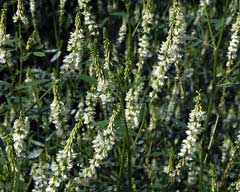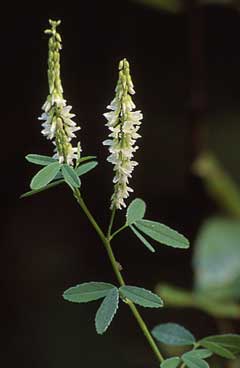 |
|
|
 |
| http://artlibre.org/licence/lal/en |
Translate this page:
Summary
Physical Characteristics

 Melilotus albus is a ANNUAL/BIENNIAL growing to 1.2 m (4ft) at a fast rate.
Melilotus albus is a ANNUAL/BIENNIAL growing to 1.2 m (4ft) at a fast rate.
It is not frost tender. It is in flower from July to August. The species is hermaphrodite (has both male and female organs) and is pollinated by Bees.
It can fix Nitrogen.
It is noted for attracting wildlife.
Suitable for: light (sandy), medium (loamy) and heavy (clay) soils and prefers well-drained soil. Suitable pH: neutral and basic (mildly alkaline) soils. It cannot grow in the shade. It prefers dry or moist soil.
UK Hardiness Map
US Hardiness Map
Synonyms
Plant Habitats
Edible Uses
Edible Parts: Flowers Leaves Oil Seed Seedpod Shoots
Edible Uses: Condiment Oil
Leaves and seedpods - cooked as a 'bean soup'[8, 105, 172]. The pea-like seeds are used as a seasoning for bean and split-pea soups[183]. Young shoots - raw or cooked[8, 172]. Added to salads or used as a potherb[183]. Only fresh shoots should be used[62], the dried leaves contain coumarin[207]. Flowers - raw or cooked[172]. Used as a vanilla-like flavouring[177, 183]. The dried leaves are said to be used as a vanilla flavouring[172] but this is probably unwise, see notes at top of the page.
References More on Edible Uses
Medicinal Uses
Plants For A Future can not take any responsibility for any adverse effects from the use of plants. Always seek advice from a professional before using a plant medicinally.
Anticoagulant Aromatic Carminative Emollient Poultice
The whole herb, harvested when in flower, is aromatic, carminative and emollient[4]. It was at one time widely esteemed as a medicinal herb, though it has fallen from favour in recent times[4]. The dried leaves contain coumarin, this can be used as an anticlotting agent for the blood[207]. The dried flowering plant has been used in ointments for external ulcers[222].
References More on Medicinal Uses
The Bookshop: Edible Plant Books
Our Latest books on Perennial Plants For Food Forests and Permaculture Gardens in paperback or digital formats.

Edible Tropical Plants
Food Forest Plants for Hotter Conditions: 250+ Plants For Tropical Food Forests & Permaculture Gardens.
More

Edible Temperate Plants
Plants for Your Food Forest: 500 Plants for Temperate Food Forests & Permaculture Gardens.
More

More Books
PFAF have eight books available in paperback and digital formats. Browse the shop for more information.
Shop Now
Other Uses
Green manure Oil Repellent
An oil obtained from the seed is used in paints, varnishes etc[114]. The dried leaves smell of new-mown hay and are used as an insect repellent[172]. The dried leaves contain a substance called coumarin, this is an anti-clotting agent and has been used as a basis of the rat killer 'warfarin'[207]. The plant is a good green manure crop[20, 87, 172]. It can be sown in the autumn and overwintered or sown from spring to mid summer. It can be cut several times for compost material before being finally incorporated into the soil[87]. Fast growing, it produces a high bulk of organic material and also fixes a large quantity of atmospheric nitrogen[87]. It can also be grown under soft and top fruit, when it will expel mice[82].
Special Uses
Attracts Wildlife Nitrogen Fixer Scented Plants
References More on Other Uses
Cultivation details
A fast growing plant[87], it dislikes shade. A good bee plant[4, 46]. The dried plant has a sweet smell of newly mown hay[245]. This species has a symbiotic relationship with certain soil bacteria, these bacteria form nodules on the roots and fix atmospheric nitrogen. Some of this nitrogen is utilized by the growing plant but some can also be used by other plants growing nearby[200].
References Carbon Farming Information and Carbon Sequestration Information
Temperature Converter
Type a value in the Celsius field to convert the value to Fahrenheit:
Fahrenheit:
The PFAF Bookshop
Plants For A Future have a number of books available in paperback and digital form. Book titles include Edible Plants, Edible Perennials, Edible Trees,Edible Shrubs, Woodland Gardening, and Temperate Food Forest Plants. Our new book is Food Forest Plants For Hotter Conditions (Tropical and Sub-Tropical).
Shop Now
Plant Propagation
Seed - sow spring to mid-summer in situ[87]. Pre-soaking the seed for 12 hours in warm water will speed up the germination process, particularly in dry weather[K]. Germination will usually take place within 2 weeks.
Other Names
If available other names are mentioned here
Native Range
TEMPERATE ASIA: Oman, Saudi Arabia (as M. alba Medic.), Yemen, Afghanistan, Cyprus, Iran, Iraq, Israel, Jordan, Lebanon, Turkey, Russian Federation-Ciscaucasia (Ciscaucasia), Armenia, Azerbaijan, Georgia, Russian Federation (Dagestan), Russian Federation-Western Siberia (Western Siberia), Kazakhstan, Kyrgyzstan, Tajikistan, Turkmenistan, Uzbekistan, China TROPICAL ASIA: Bhutan, India, Pakistan, Myanmar EUROPE: Czechoslovakia, Austria, Germany, Hungary, Poland, Russian Federation (European part), Belarus, Estonia, Lithuania, Latvia, Moldova, Ukraine (incl. Krym), Former Yugoslavia, Albania, Bulgaria, Greece, Italy, Romania, Spain, France (incl. Corsica) AFRICA: Egypt (north), Libya (north)
Weed Potential
Right plant wrong place. We are currently updating this section.
Please note that a plant may be invasive in one area but may not in your area so it's worth checking.
Conservation Status
IUCN Red List of Threatened Plants Status :

Growth: S = slow M = medium F = fast. Soil: L = light (sandy) M = medium H = heavy (clay). pH: A = acid N = neutral B = basic (alkaline). Shade: F = full shade S = semi-shade N = no shade. Moisture: D = dry M = Moist We = wet Wa = water.
Now available:
Food Forest Plants for Mediterranean Conditions
350+ Perennial Plants For Mediterranean and Drier Food Forests and Permaculture Gardens.
[Paperback and eBook]
This is the third in Plants For A Future's series of plant guides for food forests tailored to
specific climate zones. Following volumes on temperate and tropical ecosystems, this book focuses
on species suited to Mediterranean conditions—regions with hot, dry summers and cool, wet winters,
often facing the added challenge of climate change.
Read More
Expert comment
Author
Medik.
Botanical References
17
Links / References
For a list of references used on this page please go here
Readers comment
| Add a comment |
|
If you have important information about this plant that may help other users please add a comment or link below. Only comments or links that are felt to be directly relevant to a plant will be included. If you think a comment/link or information contained on this page is inaccurate or misleading we would welcome your feedback at [email protected]. If you have questions about a plant please use the Forum on this website as we do not have the resources to answer questions ourselves.
* Please note: the comments by website users are not necessarily those held by PFAF and may give misleading or inaccurate information.
To leave a comment please Register or login here All comments need to be approved so will not appear immediately.
|
Subject : Melilotus albus
|
|
|
|